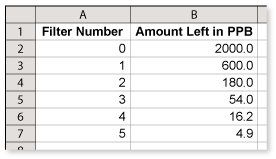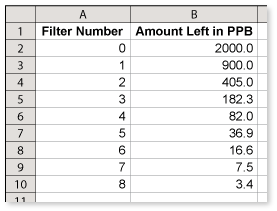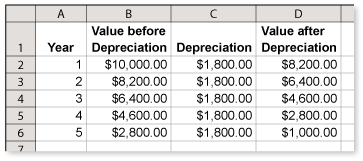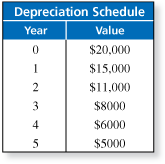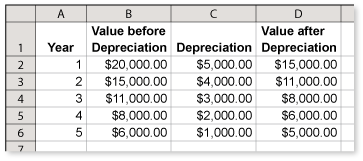-
A factory discharges wastewater into a river. The initial concentration of pollutants in the wastewater is 2000 parts per billion (ppb). Before entering the river, the water must pass through multiple filters to reduce the concentration to an acceptable level of 10 ppb. A single filter removes 70% of pollutants in the wastewater.
- What is the concentration of pollutants after passing through three filters?
- How many filters must the water pass through to meet the acceptable level?
A spreadsheet is available to help you complete this exercise.
-
Begin by making a spreadsheet that shows the parts per billion after each filter.
- The concentration of pollutants after passing through 3 filters is 54 parts per billion.
- For the concentration of pollutants to be 10 parts per billion or less, the wastewater needs to pass through 5 filters.
Comments (0)These comments are not screened before publication. Constructive debate about the information on this page is welcome, but personal attacks are not. Please do not post comments that are commercial in nature or that violate copyright. Comments that we regard as obscene, defamatory, or intended to incite violence will be removed. If you find a comment offensive, you may flag it.
When posting a comment, you agree to our Terms of Use.Showing 0 commentsSubscribe by email Subscribe by RSSThere are no comments. -
A factory discharges wastewater into a river. The initial concentration of pollutants in the wastewater is 2000 parts per billion (ppb). Before entering the river, the water must pass through multiple filters to reduce the concentration to an acceptable level of 10 ppb. A single filter removes half the pollutants in the wastewater.
- What is the concentration of pollutants after passing through four filters?
- How many filters must the water pass through to meet the acceptable level?
- Is it possible to remove all the pollutants? Explain your reasoning.
A spreadsheet is available to help you complete this exercise.
These comments are not screened before publication. Constructive debate about the information on this page is welcome, but personal attacks are not. Please do not post comments that are commercial in nature or that violate copyright. Comments that we regard as obscene, defamatory, or intended to incite violence will be removed. If you find a comment offensive, you may flag it.
When posting a comment, you agree to our Terms of Use. -
A factory discharges wastewater into a river. The initial concentration of pollutants in the wastewater is 2000 parts per billion (ppb). Before entering the river, the water must pass through multiple filters to reduce the concentration to an acceptable level of 10 ppb.
After the water passes through 1 filter, the concentration of pollutants is 900 ppb. Each filter removes the same percent of pollutants. How many filters must the water pass through to meet the acceptable level?
A spreadsheet is available to help you complete this exercise.
-
The first filter removed 1100 ppb. This is a percent decrease of

Use this percent decrease to create a spreadsheet.
For the concentration of pollutants to be 10 parts per billion or less, the wastewater needs to pass through 7 filters.
These comments are not screened before publication. Constructive debate about the information on this page is welcome, but personal attacks are not. Please do not post comments that are commercial in nature or that violate copyright. Comments that we regard as obscene, defamatory, or intended to incite violence will be removed. If you find a comment offensive, you may flag it.
When posting a comment, you agree to our Terms of Use. -
-
A factory discharges wastewater into a river. The initial concentration of pollutants in the wastewater is 2000 parts per billion (ppb). Before entering the river, the water must pass through multiple filters to reduce the concentration to an acceptable level of 10 ppb. After the water passes through 2 filters, the concentration of pollutants is 320 ppb. Each filter removes the same percent of pollutants. What is the concentration of pollutants after passing through four filters?
A spreadsheet is available to help you complete this exercise.
These comments are not screened before publication. Constructive debate about the information on this page is welcome, but personal attacks are not. Please do not post comments that are commercial in nature or that violate copyright. Comments that we regard as obscene, defamatory, or intended to incite violence will be removed. If you find a comment offensive, you may flag it.
When posting a comment, you agree to our Terms of Use. -
A factory owner buys water treatment equipment for $10,000. Make a straight-line depreciation schedule for the equipment using a useful life of 5 years and a salvage value of $1000.
A spreadsheet is available to help you complete this exercise.
These comments are not screened before publication. Constructive debate about the information on this page is welcome, but personal attacks are not. Please do not post comments that are commercial in nature or that violate copyright. Comments that we regard as obscene, defamatory, or intended to incite violence will be removed. If you find a comment offensive, you may flag it.
When posting a comment, you agree to our Terms of Use. -
-
A factory owner buys water treatment equipment for $25,000. The useful life of the equipment is 10 years, and the salvage value is $0. The factory owner uses double declining-balance depreciation. What is the value of the equipment after 5 years?
A spreadsheet is available to help you complete this exercise.
These comments are not screened before publication. Constructive debate about the information on this page is welcome, but personal attacks are not. Please do not post comments that are commercial in nature or that violate copyright. Comments that we regard as obscene, defamatory, or intended to incite violence will be removed. If you find a comment offensive, you may flag it.
When posting a comment, you agree to our Terms of Use. -
A factory owner buys $20,000 worth of water treatment equipment. The owner depreciates the equipment over 5 years, and the salvage value is $5000. The depreciation schedule for the equipment is shown. What depreciation method did the owner use? Explain your reasoning.
-
The method is not straight-line depreciation because the value is not decreasing by the same amount each year.
The method is not double declining-balance depreciation because the value is not decreasing by the same percent each year.
Of the three methods presented in Section 4.4, the only remaining method is sum of the years-digits. You can check this by creating a sum of the years-digits depreciation schedule.
From this schedule, you can see that the method is sum of the years-digits.
These comments are not screened before publication. Constructive debate about the information on this page is welcome, but personal attacks are not. Please do not post comments that are commercial in nature or that violate copyright. Comments that we regard as obscene, defamatory, or intended to incite violence will be removed. If you find a comment offensive, you may flag it.
When posting a comment, you agree to our Terms of Use. -







